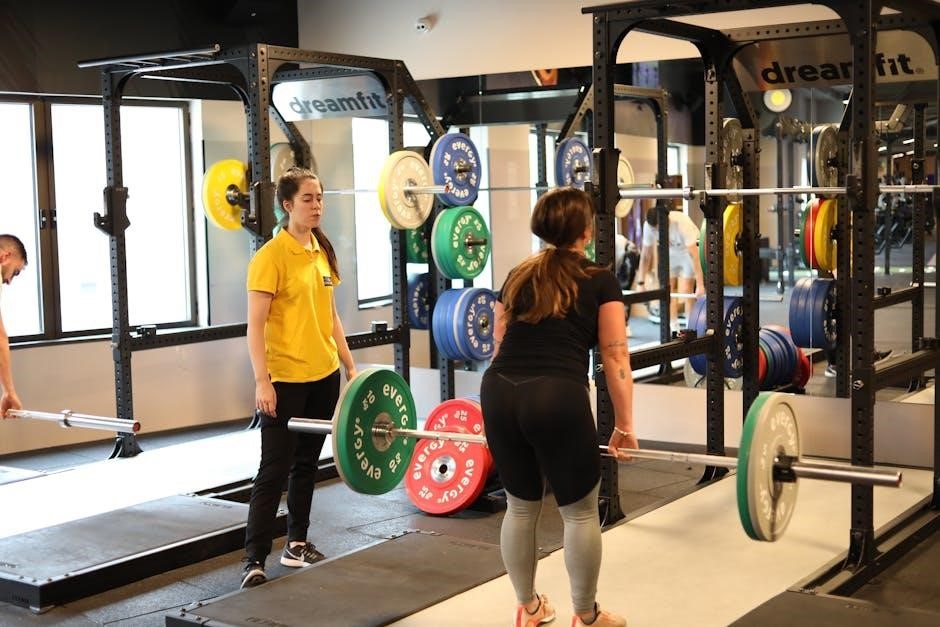Explosive Workout Program PDF: A Comprehensive Guide
This comprehensive guide provides a structured approach to enhancing explosive power. It incorporates elements from various sources, including strength training, plyometrics, and ballistic exercises. The program is designed to improve athleticism.
Explosive workouts are designed to maximize power output, blending strength and speed for enhanced athletic performance. These workouts are vital for athletes in sports requiring quick bursts of energy, such as sprinting, football, and wrestling. The core principle involves generating maximal force in minimal time, improving overall explosiveness.
This guide will explore explosive training principles and provide a structured program for developing this crucial athletic attribute. The program incorporates various exercises, including plyometrics, ballistic movements, and strength training exercises. Each component is carefully selected to optimize power development.
Furthermore, this guide will emphasize proper form and technique to prevent injuries and maximize training effectiveness. It also addresses considerations for different sports, tailoring the program to meet specific needs. With dedication and consistency, this explosive workout program can significantly enhance athletic capabilities.
What is an Explosive Workout?
An explosive workout focuses on developing the ability to exert maximal force in the shortest possible time. It’s not just about lifting heavy weights; it’s about moving those weights with speed and power. This type of training is crucial for athletes needing to generate quick, powerful movements, as seen in many sports.
Key components of an explosive workout include exercises that mimic the rapid muscle contractions required in athletic activities. Plyometrics, such as jump training, and ballistic exercises, like medicine ball throws, are essential. Strength training forms the foundation, enabling athletes to handle heavier loads with greater velocity.
The goal is to improve the rate of force development, which translates to enhanced performance in activities like sprinting, jumping, and throwing. Explosive workouts require proper technique and careful progression to minimize injury risk and maximize gains. They are distinct from standard fitness programs, prioritizing performance over general fitness.
Benefits of Explosive Training

Explosive training offers a multitude of benefits, particularly for athletes and individuals seeking to enhance their athletic capabilities. Primarily, it significantly improves power output, translating to increased speed, agility, and vertical jump height. This type of training enhances the rate at which muscles can generate force, a crucial factor in sports performance.
Beyond athletic performance, explosive training can improve overall functional fitness. It enhances neuromuscular coordination, improving the body’s ability to recruit muscle fibers quickly and efficiently. This results in better balance, stability, and reaction time.
Moreover, explosive workouts can contribute to increased muscle mass and bone density. The high-impact nature of plyometrics, a key component of explosive training, stimulates bone growth and strengthens connective tissues. Explosive training also burns calories and can aid in weight management. It’s a performance-focused approach distinct from general fitness routines, leading to tangible improvements in athletic abilities.

Key Components of an Explosive Workout Program
An effective explosive workout program integrates strength training for a solid foundation. Plyometrics are crucial for developing explosive power. Ballistic exercises further enhance power and speed. These elements combine for optimal results.
Strength Training Foundation
A strong strength training foundation is paramount to developing explosive power. This phase focuses on building a base level of strength that supports subsequent explosive movements. Exercises such as squats, deadlifts, and bench presses are fundamental in this stage. These compound exercises engage multiple muscle groups simultaneously, promoting overall strength gains.
The goal is to increase the athlete’s ability to exert force against resistance, which directly translates to improved explosiveness. Strength training lays the groundwork for plyometrics and ballistic exercises. Without a solid strength base, the risk of injury increases during high-impact activities. Coaches should emphasize correct form and technique.
Prioritizing proper mechanics ensures that the muscles are engaged effectively and safely. This phase typically involves lower repetitions with heavier weights to stimulate maximal strength development. Strength training is not merely about lifting heavy weights; it’s about developing a robust foundation for explosive movements.
Plyometrics for Explosiveness
Plyometrics are a crucial component of any explosive workout program. These exercises involve rapid stretching and contracting of muscles, enhancing the rate of force development. Plyometrics train the body to use the stretch-shortening cycle effectively, allowing for more powerful movements. Examples include box jumps, depth jumps, and medicine ball throws.
These exercises improve an athlete’s ability to generate force quickly, which is essential for explosive sports. Plyometrics apply an overload to the muscles with explosive speed strength. This phase builds upon the strength foundation, translating strength into power. Proper technique is critical to avoid injuries.
Athletes must focus on landing softly and maintaining control throughout the movements; The intensity and volume of plyometric exercises should be gradually increased to prevent overtraining. Plyometrics are not just about jumping high or far; they are about improving the efficiency of muscle contractions. They contribute significantly to overall explosiveness and athletic performance.
Ballistic Exercises
Ballistic exercises are movements where you maximize acceleration throughout the entire range of motion, often involving the release of an object. These exercises enhance power output and translate directly to athletic performance. Examples include jump squats, medicine ball throws, and Olympic lifting variations like power cleans and snatches.

Unlike traditional strength training, ballistic exercises focus on moving the load as fast as possible. This approach recruits high-threshold motor units and improves the nervous system’s ability to generate rapid force. Medicine ball exercises, in particular, are effective for developing explosive power in the upper body.
Ballistic training is essential for athletes needing to produce maximum power in short periods. Incorporating ballistic exercises into a workout program bridges the gap between strength and speed. However, proper technique and a solid strength foundation are crucial before implementing these movements. Emphasis should be placed on controlling the load and maintaining proper form.

Designing Your Explosive Workout Program (PDF)
Crafting an effective program requires careful planning. Assess your current fitness level. Set realistic goals. Then, select appropriate exercises. Ensure proper form. Progress gradually. A PDF can help track progress.
Assessment and Goal Setting
Before embarking on any explosive workout program, a thorough assessment is crucial. Evaluate your current strength, speed, and power levels. Identify any weaknesses or imbalances that need to be addressed. Consider your training history and any previous injuries. This initial assessment will serve as a baseline for measuring progress and tailoring the program to your specific needs.
Setting clear and achievable goals is equally important. Define what you want to achieve with the explosive workout program. Are you aiming to increase your vertical jump, improve your sprint speed, or enhance your overall power output? Your goals should be specific, measurable, attainable, relevant, and time-bound (SMART). For example, a goal could be to increase your vertical jump by 2 inches in 12 weeks. Having well-defined goals will provide motivation and direction throughout the program.
Sample Explosive Workout Exercises (PDF)
The PDF provides a range of explosive exercises designed to enhance power and athleticism. These exercises incorporate plyometrics, ballistic movements, and explosive lifts. Examples include plyometric jumps like box jumps and depth jumps, which overload muscles with explosive speed. Ballistic exercises such as medicine ball throws and jump squats are also included. These movements teach athletes to initiate force with maximal effort.
The PDF also features explosive lifts, potentially incorporating Olympic lifts or their variations, depending on the athlete’s experience and goals. The exercises are structured to target different muscle groups and movement patterns involved in explosive activities. Remember to consult the PDF for a comprehensive list of exercises. It’s important to note that the specific selection of exercises may vary depending on the individual’s sport, training experience, and goals. Proper form and technique are essential for maximizing results and minimizing the risk of injury.
Exercise Demonstrations (Via Clickable Links)
To ensure proper form and technique, the PDF includes clickable links to video demonstrations of each exercise. These links will take you to external resources where you can observe the exercises being performed correctly. Watching these demonstrations is crucial for understanding the proper movement patterns, body positioning, and execution of each exercise. This visual aid helps to prevent injuries and maximize the effectiveness of the workout.
By clicking on the provided links, you can access detailed instructions and visual guidance for exercises. The clickable links provide easy access to demonstrations from your computer or mobile device. This feature allows you to learn the correct form, ensuring safe and effective training. The exercises include plyometric jumps, ballistic exercises, and explosive lifts. Remember to prioritize proper form over the amount of weight lifted or repetitions performed.

Program Structure and Periodization
This program employs a structured, phased approach, incorporating strength, speed, and plyometric phases. Periodization optimizes results, preventing plateaus and reducing injury risk. Proper planning is essential for long-term progress.
Phases of Training: Strength, Speed, Plyometrics
This explosive workout program is structured into three distinct phases: Strength, Speed, and Plyometrics. Each phase builds upon the previous one, progressively enhancing explosive power and athletic performance. The Strength phase focuses on developing a solid foundation of muscular strength, utilizing compound lifts.
The Speed phase transitions to lighter weights and higher velocities, emphasizing the rate of force development. Ballistic exercises are incorporated to improve the ability to move quickly.
The Plyometrics phase harnesses the stretch-shortening cycle to generate explosive movements. Jump training and other plyometric drills are utilized to enhance power output. This phased approach ensures a well-rounded and effective training program, minimizing risk and maximizing gains. This is critical for athletes.

12-Week Program Example
This 12-week explosive workout program is designed to enhance strength, speed, and power. The program is divided into three phases: Strength (Weeks 1-4), Speed (Weeks 5-8), and Plyometrics (Weeks 9-12).
During the Strength phase, focus on compound exercises like squats, deadlifts, and bench presses. Aim for 3-5 sets of 5-8 repetitions.
The Speed phase incorporates lighter weights with faster movements. Include exercises like power cleans and push presses, performing 3-4 sets of 6-8 repetitions.
The Plyometrics phase emphasizes explosive movements such as box jumps and medicine ball throws. Perform 3-4 sets of 8-12 repetitions. This phased approach progressively builds explosiveness. Remember proper warm-up and cool-down routines. Adjust based on individual needs.
Integrating Olympic Lifts
Olympic lifts, such as the snatch and clean & jerk, are highly effective for developing explosive power. These lifts require the athlete to generate maximal force rapidly, engaging multiple muscle groups simultaneously. Integrating Olympic lifts into an explosive workout program can significantly enhance athletic performance.
Start with proper technique training, focusing on mastering the fundamental movements before adding significant weight. Progress gradually, increasing the load as technique improves. Incorporate variations like power cleans and power snatches to focus on specific aspects of explosiveness.
Olympic lifts should be performed early in the workout, when the athlete is fresh. Limit the number of repetitions to maintain high intensity and avoid fatigue. Combine them with plyometrics and ballistic exercises for a comprehensive explosive training approach. Ensure proper coaching and supervision.

Considerations for Different Sports

Explosive workout programs must be tailored to the specific demands of each sport. Sprinters, football players, and wrestlers, for example, require different types of explosive movements and training focuses to maximize their performance.
Explosive Workouts for Sprinters (Noah Lyles Example)
Sprinters, like Noah Lyles, require explosive power for rapid acceleration and top-end speed. Their training focuses on developing maximal force production in a short amount of time. Workouts often incorporate plyometrics, such as jumps and bounds, to improve reactive strength and elasticity.
Olympic lifts, like cleans and snatches, are also beneficial for developing overall power. These lifts teach the athlete to generate force quickly against a resistance. The Noah Lyles example highlights the importance of pillar strength and stability.
Specific exercises might include medicine ball throws, resisted sprints, and plyometric variations that mimic the sprinting motion. Short rest periods are crucial for maintaining workout intensity. This type of training develops an athlete’s explosive capability.
Explosive Workouts for Football
Football demands explosive power for various actions, including sprinting, jumping, tackling, and changing direction. A comprehensive explosive workout program for football players should incorporate elements of strength training, plyometrics, and speed work. The goal is to develop the ability to generate high levels of force quickly.
Strength exercises might include squats, deadlifts, bench press, and Olympic lifts to build a solid foundation. Plyometrics, such as box jumps, hurdle hops, and medicine ball throws, enhance reactive strength and power. Speed drills focus on improving acceleration, agility, and top-end speed.
The program should be tailored to the specific position and needs of the player. For example, linemen require explosive power for blocking and tackling, while receivers need it for jumping and sprinting. The training program needs to be comprehensive.
Explosive Workouts for Wrestling
Wrestling requires a unique blend of strength, agility, and explosive power. An effective explosive workout program for wrestlers needs to focus on developing these attributes. The program should incorporate exercises that mimic the demands of wrestling, such as takedowns, sprawls, and escapes.
Strength training should include compound exercises like squats, deadlifts, and rows to build a solid base. Explosive exercises, such as plyometrics and Olympic lifts, are crucial for developing the ability to generate power quickly. Examples include box jumps, medicine ball throws, and power cleans.
Additionally, wrestling-specific drills, such as sprint workouts and jump rope programs, should be integrated to improve conditioning and agility. The program should also consider the wrestler’s weight class and individual needs, tailoring the exercises and intensity accordingly. This will improve performance and prevent injuries.

Important Considerations
Prioritize proper form and technique to avoid injuries. Include a thorough warm-up and cool-down routine. Heed all safety precautions. Modify the program to suit individual needs and fitness levels.
Proper Form and Technique
Maintaining proper form and technique is paramount when performing explosive exercises. This ensures safety and maximizes the effectiveness of the workout. Each movement should be executed with precision, focusing on control and body alignment. Prioritize quality over quantity, especially when starting.
Before increasing the intensity or weight, master the fundamental movement patterns. Video analysis or guidance from a qualified coach can be invaluable in identifying and correcting any flaws in your technique. Pay close attention to posture, joint angles, and muscle engagement throughout each exercise.
Improper form can lead to injuries, hindering progress and potentially causing long-term damage. Therefore, dedicate time to learning and refining your technique. Start with lighter loads or bodyweight exercises to build a solid foundation. As your strength and coordination improve, gradually increase the challenge while maintaining impeccable form. Remember, consistency and attention to detail are key to achieving optimal results and preventing injuries.
Warm-up and Cool-down
A proper warm-up is crucial before any explosive workout. It prepares the muscles and joints for the demands of the training session. A dynamic warm-up increases blood flow, improves flexibility, and enhances neuromuscular activation. Include exercises like arm circles, leg swings, torso twists, and light cardio.
The warm-up should gradually increase in intensity, mimicking the movements of the workout. This primes the body for optimal performance and reduces the risk of injury. Spend at least 10-15 minutes warming up before starting the explosive exercises.
Similarly, a cool-down is essential after the workout. It helps the body recover and reduces muscle soreness. A static stretching routine, holding each stretch for 20-30 seconds, is ideal. Focus on the muscles worked during the session. Light cardio, such as walking, can also aid in recovery. The cool-down should last for 5-10 minutes.
Safety Precautions
Prioritizing safety is paramount in any explosive workout program. Before starting, ensure you have a solid strength foundation. Proper form and technique are critical to prevent injuries. If you are new to explosive training, consider working with a qualified coach or trainer.
Start with lighter loads and gradually increase the intensity as your strength and technique improve. Listen to your body and avoid pushing through pain. Adequate rest and recovery are essential for preventing overtraining.
Ensure the training environment is safe and free from obstacles. Use appropriate footwear and protective gear when necessary. Stay hydrated by drinking plenty of water before, during, and after workouts. If you have any pre-existing medical conditions, consult with a healthcare professional before starting the program. Modify exercises as needed to accommodate any limitations. Always prioritize safety and well-being.
